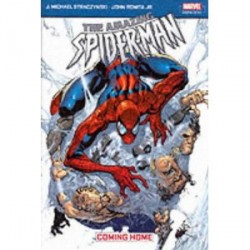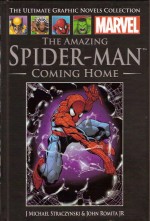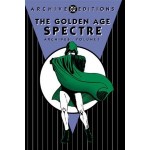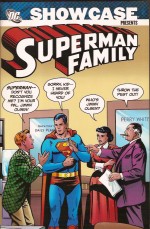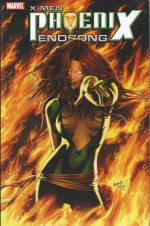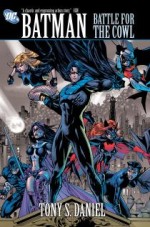
By Tony S. Daniel, Sandu Florea, Fabian Nicieza & various (DC Comics)
ISBN: 978-0-4012-2417-2
I’m innately suspicious of and generally hostile to big, bombastic braided crossover events in comics.
Does any other popular art form use them yet, or are they too often simply an excuse to shear cash from hard-up fans?
(Coming Soon to Your Screen: CSIs Las Vegas, Miami, New York and Croydon must race both NCISs, all the various Law & Orders, The Bill and Inspector Montalbano to battle an international conspiracy and discover who ate all the pies on Man vs. Food, with sidebar stories on Holby City, Grey’s Anatomy and Body of Proof, whilst Cold Case investigates the connection to an unsolved Miss Marple poisoning before Dr. Who wraps it up in a time-spanning Christmas Special…)
Undoubtedly in terms of mainstream superhero stories, with some key characters spread out over many titles, epochal continuity events can and should be reflected in all the various comicbooks, but the whipping up of buyer’s frenzy until readers don’t dare miss any mention or moment of an event has always struck me as cruel and unusual punishment directed towards the people who love you most – and that’s just abuse, plain and simple…
That’s not to say that some pretty impressive yarns haven’t resulted from the practice and undoubtedly the modern wrinkle of producing discrete “Nested Storylines†within the broader framework has eased the previously daunting burden somewhat – although that might be more a necessary function of the increasingly important trade paperback/graphic novel market: after all who could even lift a book containing every episode and instalment of Civil War or Crisis on Infinite Earths?
Even so, I prefer not to get caught up in the hype and furore if at all possible, and even re-reread such blockbusters before passing my own awesome, implacable Final Judgement…
Thus with all the fervour and kerfuffle surrounding the epic death and inevitable resurrection of Batman finally finished and forgotten, now seems the moment to take another look at one the critical elements of the positively vast Batman R.I.P./Final Crisis/Last Rites/Batman Reborn/Return of Bruce Wayne affair to see how it stands bereft of hysteria…
Following a harrowing and sustained campaign of terror by insidious cabal The Black Hand, the mighty Batman was apparently killed by diabolical New God Darkseid during the “Final Crisisâ€. Although the news was kept from the general public, the superhero community secretly mourned and a dedicated army of assistants, protégés and allies assembled through the years by the Dark Knight formed a “Network†of champions to police Gotham City in the tumultuous days and weeks that followed…
This slim volume collects the contents of core miniseries Batman: Battle for the Cowl #1-3 plus themed anthology specials Gotham Gazette: Batman Dead? #1 and Gotham Gazette: Batman Alive? #1 (March-July 2009) recounting how with the city descended into chaos as the hard-pressed Network strive against a three-way power struggle whilst hoping to keep their patriarch’s legacy alive…
Most of the Batman-trained Network refuse to believe their inspirational mentor is dead and thus, believing him only lost, have urged Dick Grayson – first Robin , now Nightwing – to assume his teacher’s identity again (as he did post-KnightFall during the Batman: Prodigal storyline) until Bruce Wayne can find his way back to them. This, the bereaved junior hero has steadfastly refused to do…
Written and pencilled by Tony S. Daniel with inks from Sandu Florea, the epic opens during ‘A Hostile Takeover’ with third Robin Tim Drake and his British analogue The Squire valiantly battling a gang of killer clowns only to find their job finished for them by an unseen vigilante who deals out justice with extreme violence and leaves little love-notes declaring “I AM BATMANâ€â€¦
As an army of heroes – including The Knight, Wildcat, Birds of Prey, Outsiders and even a new Batwoman work with the police to maintain order, but as the Dark Knight hasn’t been seen for weeks Gotham’s criminal classes are beginning to suspect that something has happened to their greatest nemesis…
Already moving to consolidate power are The Penguin and Two-Face: each attempting to create an insurmountable powerbase and win complete control of the underworld by the time the Batman shows his face again, but unknown to each a third player has begun his own campaign.
Black Mask is a sadistic psychotic – but a methodical and strategically brilliant one. His first move is to free a busload of Batman’s most maniacal menaces being shipped back to Arkham Asylum and let them loose to add to the chaos and carnage…
Meanwhile Tim continually presses Nightwing to assume the mantle of the Bat, arguing that even a fake Caped Crusader will have a terrifying calming effect onGotham’s rampant rogues and robbers.
Moreover, it must be one of them, rather than allowing the increasingly out-of-control mystery impostor to steal the role and tarnish the legend…
Grayson again refuses before heading back to damage control leaving Tim to track the fake as he brutally demolishes and even murders malefactors throughout the city. With a chilling inkling as to the fraud’s identity, Drake himself puts on the cowl and costume to hunt the killer to his hidden lair beneath Gotham’s sewers, even as Bruce Wayne’s assassin-trained son Damian – continuing as the headstrong and potentially lethal latest iteration of Robin, the Boy Wonder – is attacked by liberated lunatics Poison Ivy and Killer Croc and a horde of lesser criminals.
Even after Nightwing swings in to assist, the odds seem hopeless …until the Fake Knight bursts in, all guns blazing…
‘Army of One’ finds Nightwing battling the killer charlatan to a standstill amidst the bodies of his dead and dying attackers and reaching the same conclusion Tim had. The blood-hungry facsimile is Jason Todd …
Another orphan taken in by Batman, Todd served valiantly as the second Boy Wonder but his psychological problems remained hidden and unresolved and the boy was murdered by the Joker. Subsequently resurrected by one of the frequent Cosmic Upheavals (Infinite Crisis if you’re interested, but it all happened off-camera and post hoc…) that plague the DC Universe, the boy took on the identity of the Red Hood and began cleaning up Gotham his way; using his Bat-training and the merciless tactics of the villains he remorselessly stalked. Now with the role of Dark Knight vacant he intends to become theBatmanGothamCity always deserved…
Unable to defeat each other, the impasse between Nightwing and the killer Caped Crusader is broken when Birds of Prey Huntress and Black Canary arrive. Todd simply shoots Damian in the chest and escapes whilst the heroes rush to tend the boy…
Black Mask, meanwhile, is deploying more of the freed Arkham inmates; using them to covertly amp up the death-struggle between Two-Face and the Penguin. Deep below Gotham Tim, still dressed as his teacher, searches Todd’s hideout and encounters a far from friendly Catwoman…
As Grayson and Alfred doctor the wounded Damian in the Batcave, Black Mask’s sinister subordinates blow up Police Headquarters, whilst Catwoman and Tim search Todd’s files for clues. Her hostility had stemmed from the lad wearing her ex-lover’s clothes, but she’s a lot angrier when the impostor returns and attacks…
Leaving them both for dead, Todd then moves to his lethal endgame intent on being the ‘Last Man Standing’…
As Nightwing gathers his Network to tackle the mounting chaos, Black Mask unobtrusively takes full control of the underworld and Grayson at last realises that only one man can be allowed to carry the burden of being Batman. All he has to do is beat Jason, who has brutally removed and almost murdered every other contender for the Cowl…
Book-ending the actual event, but safely tucked in at the back of this book, were a brace of anthology specials scripted by Fabian Nicieza and focussing on some of the supporting characters involved in the affair.
Thus Gotham Gazette: Batman Dead? #1 introduces a new player in ‘The Veil’ – illustrated by Dustin Nguyen (who also provided covers for both comics) – an enigmatic figure hidden in shadows and cogently assessing the situation for both her and our benefit, after which disgraced reporter and ex-Wayne girlfriend ‘Vicki Vale’ begins to investigate her former beau in a tantalising teaser limned by Guillem March.
Temporary hero ‘Stephanie Brown’ (The Spoiler and, briefly, Robin Mark IV) returned to the city after being run out of town by Batman and soon stumbles back into her old ways after seeing her ex-boyfriend Tim Drake hunting the deliriously larcenous Nocturna (art from ChrisCross), whilst Bruce Wayne’s closest confidante and replacement mum ‘Leslie Thompkins’ also snuck back in, determined as ever to open a free clinic for the underprivileged.
Illustrated by Jamie McKelvie, the tale showed why Batman closed her down as she quickly began treating escaped lunatics like the Cavalier, regardless of how many innocents they had harmed…
The first collection closed with a glimpse at bad cop ‘Harvey Bullock’ (Alex Konat & Mark McKenna) given one more “last chance†by Commissioner Gordon and determined to find a killer who beheaded his victims…
Gotham Gazette: Batman Alive? #1 resumed all of these opened affairs with all the same creators finishing what they started.
‘The Veil’ at last reached her conclusions and passed judgement on the new Batman whilst ‘Harvey Bullock’ identified his mystery killer and opened the doors for a new Azrael to haunt the city’s criminals and ‘Leslie Thompkins’ proved that her help could provide redemption for even the most lost and depraved souls…
‘Stephanie Brown’ then began her own road back by taking up her original costumed identity as ‘Vicki Vale’ began piecing together many threads to uncover absentee playboy Bruce’s darkest, most incredible secret…
This collection also offers the assorted covers and variants the comicbooks generated, dotted throughout the saga, and this tumultuous tome concludes with ‘Building the Network’ Â – a copious collection of pencilled cover art, story-pages and sketches by Daniel that will dazzle and delight those interested in the creative process.
So what’s the verdict? Actually, I’d go with a tentative “thumbs up 
There’s not much plot to wrestle with, but the action and drama are kept to an angsty maximum and, even though not all the characters and backstory might be familiar to new or casual readers, the pace and delivery will carry fans of the genre along with suitable panache. Moreover it’s all very, very pretty to look at and even the freshest neophyte is well aware that it’s all just a prelude to the return of the real Dark Knight…
© 2009 DC Comics. All Rights Reserved.


